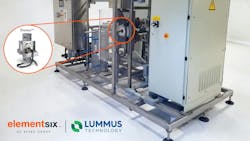Element Six and Lummus Technology announce global partnership
Editor's note: This article was updated on July 23, 2024, to include comments provided by Bruce Bolliger, head of business development, North America, Element Six, via email.
Element Six (E6) and Lummus Technology announced an exclusive global partnership on July 23, 2024, that will leverage a unique solution to address the worldwide challenge of per- and polyfluoroalkyl substances (PFAS) destruction.
E6 develops and manufactures chemical vapor deposition (CVD) diamond solutions. Lummus technology is a global provider of process technologies and value-driven energy solutions.
The U.S. Environmental Protection Agency (EPA) announced Maximum Contaminant Levels (MCLs) for PFAS on April 10, 2024. The MCLs regulate the maximum amount of four PFAS contaminants in drinking water.
Government agencies across the world including the UK, Europe, Australia and the Middle East are also taking steps to regulate these compounds presence in drinking water and everyday consumer products.
PFAS do not naturally break down in the environment and can cause health problems in high exposure cases, including cancer, decreased immunity and infertility.
The new partnership combines E6’s patented boron-doped diamond (BDD) electrochemical oxidation technology with Lummus’ patented electro-oxidation technology and system integration for water and wastewater treatment.
Lummus and E6 have tested their combined technologies using free-standing BDD electrodes, which resulted in successful destruction of long and short chain PFAS.
Free-standing BDD electrodes, as opposed to metal electrodes plated with BDD, enable high current densities that destroy short-chain PFAS.
Lummus and E6 are making progress with customers to address numerous real-life applications leveraging this novel BDD electrochemical oxidation technology.
Benefits of the new technology
Water treatment systems for PFAS comprise of two major processes stated Bruce Bolliger, head of business development, North America, Element Six.
"1) First separation and concentration of PFAS from the contaminated effluent stream and then 2) destruction of the remaining concentrated PFAS media. Granular activated carbon (GAC), ion exchange, and reverse osmosis (RO) are methods for achieving the first step: separation and concentration of PFAS," said Bolliger in an email.
"But then this contaminated media, such as resins from ion exchange or membranes from RO, must either be disposed of or destroyed. Current disposal methods, such as depositing the media into a landfill or incinerating the media, have drawbacks because the environment can become re-contaminated. For instance, landfill leachate now will contain PFAS that seeps back into the environment. Or unless the incineration is done at extraordinary temperatures with special out-gassing handling, incineration can just return PFAS compounds back into the air. This new electrochemical oxidation technology from Element Six and Lummus Technology destroys the PFAS completely, thus preventing the PFAS from returning to the environment and thus ending the cycle of contamination," said Bolliger.
Bolliger stated that the new technology from E6 and Lummus Technology uses free-standing, i.e. without a substrate, boron-doped-diamond (BDD) electrodes. He said that there are no competitors using free-standing BDD electrodes in electrochemical oxidation reactors on the market today.
"This new technology from Element Six and Lummus Technology uses free-standing, i.e. without a substrate, boron-doped-diamond (BDD) electrodes. There are no competitors using free-standing BDD electrodes in electrochemical oxidation reactors on the market today," said Bolliger. "There are quite a variety of competing technologies, including BBD-coated metal-substrate electrodes in electrochemical oxidation reactors, ultraviolet (UV) light, plasma, sonification, and so on. These technologies report various levels of effectiveness at destroying PFAS compounds, depending on the specific application."
The cost of PFAS destruction
Bolliger stated that the econmonics of solutions are very dependent on the specific application being addressed, and that the cost of the PFAS destruction itself often will be a smaller portion of the overall water-treatment solution that includes both PFAS separation and PFAS destruction as well as the need to address non-PFAS organics in the effluent to be treated.
"Because of the modular nature of the technology from Element Six and Lummus Technology, however, capital cost can be optimized for each application by matching the number of modules to the required capacity," said Bolliger. "Lummus Technology is currently working on economic models for operating costs and verifying these models with field data to date. This is work in progress, however, the operating costs based on this modelling so far appear competitive with today’s cost of incineration in North America or Europe."
